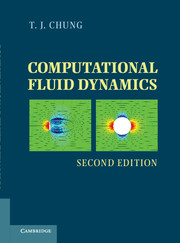Book contents
- Frontmatter
- Contents
- Preface to the First Edition
- Preface to the Revised Second Edition
- Part One Preliminaries
- Part Two Finite Difference Methods
- Part Three Finite Element Methods
- Chapter Eight Introduction to Finite Element Methods
- Chapter Nine Finite Element Interpolation Functions
- Chapter Ten Linear Problems
- Chapter Eleven Nonlinear Problems/Convection-Dominated Flows
- Chapter Twelve Incompressible Viscous Flows via Finite Element Methods
- Chapter Thirteen Compressible Flows via Finite Element Methods
- Chapter Fourteen Miscellaneous Weighted Residual Methods
- Chapter Fifteen Finite Volume Methods via Finite Element Methods
- Chapter Sixteen Relationships Between Finite Differences and Finite Elements and Other Methods
- Part Four Automatic Grid Generation, Adaptive Methods, and Computing Techniques
- Part Five Applications
- Appendixes
- Index
- References
Chapter Sixteen - Relationships Between Finite Differences and Finite Elements and Other Methods
from Part Three - Finite Element Methods
Published online by Cambridge University Press: 05 June 2012
- Frontmatter
- Contents
- Preface to the First Edition
- Preface to the Revised Second Edition
- Part One Preliminaries
- Part Two Finite Difference Methods
- Part Three Finite Element Methods
- Chapter Eight Introduction to Finite Element Methods
- Chapter Nine Finite Element Interpolation Functions
- Chapter Ten Linear Problems
- Chapter Eleven Nonlinear Problems/Convection-Dominated Flows
- Chapter Twelve Incompressible Viscous Flows via Finite Element Methods
- Chapter Thirteen Compressible Flows via Finite Element Methods
- Chapter Fourteen Miscellaneous Weighted Residual Methods
- Chapter Fifteen Finite Volume Methods via Finite Element Methods
- Chapter Sixteen Relationships Between Finite Differences and Finite Elements and Other Methods
- Part Four Automatic Grid Generation, Adaptive Methods, and Computing Techniques
- Part Five Applications
- Appendixes
- Index
- References
Summary
Our explorations on the methods of finite differences and finite elements have come to an end. In Chapter 1, it was intended that the reader recognize the analogy between these two methods in one dimension. In fact, such an analogy exists for linear problems in all multidimensional geometries as long as the grid configurations are structured. In structured grids, with adjustments of the temporal parameters in generalized Galerkin methods and both temporal and convection diffusion parameters in generalized Petrov-Galerkin methods, the analogy between finite difference methods (FDM) and finite element methods (FEM) can be shown to exist also.
Traditionally, FEM equations are developed in unstructured grids as well as in structured grids. The FEM equations written in unstructured grids have global nodes irregularly connected around the entire domain, thus resulting in a large sparse matrix system, but the data management can be handled efficiently by using the element-by-element (EBS) assembly as discussed in Sections 10.3.2 and 11.5. FDM equations cannot be written in unstructured grids unless through FVM formulations. Thus, the FDM equations written only in structured grids cannot be directly compared with FEM equations written in general unstructured grids. Thus, the notion of FEM being more complicated, requiring more computer time than FDM, is an unfortunate comparison. For fair comparisons, FEM equations must be written in structured grids as in FDM.
- Type
- Chapter
- Information
- Computational Fluid Dynamics , pp. 519 - 540Publisher: Cambridge University PressPrint publication year: 2010



